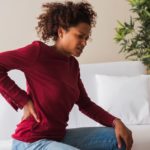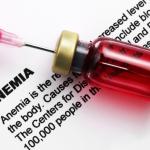If you are struggling with fibroids, you’re not alone. Fibroids are a common problem that impacts millions of women’s lives every year. They can cause pain and discomfort, interfere with your personal and work life, cause unpredictable symptoms, and affect your chances of getting pregnant. Likewise, if you are close to menopause, fibroids can also cause pain and discomfort.
When most people first think of uterine fibroid symptoms, they usually picture common issues like heavy bleeding, frequent urination, bloating, cramping, uterus and lower back pain, or bleeding between periods. However, a lesser-known symptom of uterine fibroids is lower back pain and pressure that becomes more persistent as the fibroids grow.
Below, we discuss fibroids, back pain, and leg pain. You may be asking, “Do fibroids cause pain?” Or maybe you’re wondering whether fibroids may be causing your symptoms.
Common Fibroid Pain Locations
Uterine fibroids can cause pain and discomfort in areas throughout a woman’s body. A research study found that women with fibroids were more likely to report moderate or severe pain during sex, and even noncyclic pelvic pain (pelvic pain unassociated with other conditions) than women without fibroids.
The severity of symptoms depends on the size, location, and number of fibroids present. Below are some of the common causes of pain from different types of uterine fibroids:
- Intramural and submucosal fibroids inside your uterus can distort its shape
- Subserosal fibroids located on the outside of your uterus can press against your bladder, rectum, or spinal nerves, causing back pain, abdominal pressure, and swelling
- Pedunculated fibroids are attached to the uterus by a stalk. If they become twisted, they cause pain.
Fibroids can put pressure on the sciatic nerve, causing back pain, which can also radiate through the buttocks, hips, and legs, as well as pain in the uterus and lower back
If you are experiencing pain or discomfort due to fibroids, it may be time to explore your treatment options for how to get rid of fibroid back pain. If you wonder, “Where is fibroid pain felt?” consider the following locations.
Abdominal Pain
Women with large fibroids often experience pelvic and/or abdominal discomfort. This may present as severe pain localized to a specific spot or can be mild but affect a larger area of the body.
Fibroids can also cause abdominal or belly pain that negatively impacts your digestive system. If a fibroid is large enough, it can push down on the rectum, making bowel movements difficult which may cause constipation. Excessive rectal pressure due to constipation can also result in hemorrhoids, which occur due to swollen veins in the anus.
Fibroids can increase the pain from menstrual cramping, causing it to be more severe than normal. As the fibroid grows, it can distend your uterus, causing your abdomen to appear larger than normal.
Back Pain
One of the areas where fibroid pain is felt is in the back. Fibroids can press against the nerves in the lower back or push on the muscles, which may result in pain. Larger fibroids usually are the culprit as small fibroids are less likely to have enough pressure to result in pain outside the uterus.
Leg Pain
Fibroids can cause leg pain if they press on nerves or muscles. This usually happens with larger fibroids and those that grow on the outside of the uterus. Pain in the lower back can radiate down the leg, causing widespread discomfort.
Headache
Some women with fibroids experience headaches due to anemia. Iron deficiency anemia, a common symptom of fibroids, is a condition in which you lack enough red blood cells to carry adequate oxygen throughout your body.
If you experience back, leg, or pelvic pain, we recommend consulting with a fibroid specialist to determine its underlying cause. The answer to the question, “Do fibroids cause pain?” is “yes.” But you can get relief with fibroid treatment.
What Does Pain from Fibroids Feel Like?
Pain from fibroids can vary, depending on the location and size. For instance, a fibroid that is degenerating may cause acute pain that is severe in one area. Chronic pain in the pelvic area is often dull and mild. It may be persistent and focused on one area.
Sometimes, the fibroid causes more discomfort, such as a heavy feeling in the abdomen or pressure on certain organs. The pain may be sharp if the fibroid presses on nerves, muscles, or organs. The answer to the question, “What does fibroid pain feel like?” can range from mild and dull to acute and severe, so an accurate diagnosis is necessary for treatment.
Is it Normal for Fibroids to hurt?
Fibroids can cause pain in your back, legs, and pelvis because they can compress the nerves, veins, or arteries in your pelvic region. When these stay compressed, the pain can spread to your hips, down your legs, and into your lower back. It becomes a more serious condition when you have severe pelvic pain coupled with bleeding.
Discomfort During Sex
In addition to abdominal discomfort, some women with large fibroids may endure pain during sex. Depending on your individual situation, you may feel pain only in certain positions or constant pain throughout intercourse. We want women to know that pain during sex is not normal and should be investigated. A pelvic exam or ultrasound can determine whether fibroids or another health condition is causing intercourse to be painful.
Causes of Pain from Different Types of Uterine Fibroids
Certain types of fibroids cause more pain than others. For instance, intramural fibroids may lead to lower back or pelvic pain. They grow within the uterus walls, and symptoms may worsen as they get bigger.
Subserosal fibroids grow outside of the uterus. They can cause pain within the abdomen as they grow and impact other organs. The abdomen or stomach may feel full or heavy.These fibroids can also cause cramping and abdominal pain. Since they are attached by a stalk on the outside of the uterus, they may cause acute pain if the stalk gets twisted and shuts off the blood supply.
Submucosal fibroids may also cause pain in the lower back or pelvic area. They grow in the inner lining of the uterus. They also lead to heavy bleeding, bleeding between periods, and prolonged menstruation.
Calcified fibroids occur when the fibroid has outgrown its blood supply and starts to die. It can lead to severe abdominal pain or heavy pressure in the abdominal area.
Solve Pain with Uterine Fibroid Embolization (UFE)
If you suffer from abdominal discomfort, back and leg pain, or pain in the uterus and lower back due to fibroids, we want you to know that help is available. Instead of just treating chronic symptoms, treatment can address their underlying cause: the fibroids themselves, which can alleviate symptoms altogether.
Wondering how to get rid of fibroid back pain? At USA Fibroid Centers, we offer a minimally invasive treatment called Uterine Fibroid Embolization (UFE). UFE can shrink your fibroids, relieve your back and leg pain, and improve your quality of life.
Unlike fibroid surgery, UFE is performed in an outpatient setting. This means that you can begin your recovery in the comfort of your own home. Most women are back to their normal activities within the first week or two.
Explore Your Treatment Options at USA Fibroid Centers
At USA Fibroid Centers, our leading fibroid specialists will evaluate your fibroid symptoms. To ensure a clear diagnosis, we may suggest further imaging or testing such as an ultrasound or MRI. After an initial consultation, we will make treatment recommendations that will fit your needs and lifestyle to help reduce pain from fibroids.
We have locations throughout the country for your convenience, along with virtual doctor appointments. Call 855.615.2555 to schedule a consultation at a location near you or make an appointment online today.
Sources:
- UCSF Health. Fibroid Signs and Symptoms.
- Cleveland Clinic. (August 2020) Uterine Fibroids.



